Where Did Dogs Come From?

For a few years, I taught a college seminar called Pets and People—and loved it. Students also got excited by the course, even though it was part of the dreaded general education requirements. I find that people like learning about the animals in their lives–especially students who have had to leave their beloved pets back home.
Since it was an inquiry, research, and writing course, I wanted to make the inquiry and research genuine for the students. So, on the first day of class, they broke into small groups to talk about what they wanted to learn, wrote questions on big sticky notes, and posted all the notes on a wall. We then clustered related questions together so we could identify and choose a few learning goals for the course. They chose animal domestication every time.
If I’d been a student in the course, I would have written “How were animals domesticated?” on my sticky note, too. I had a vague notion that humans domesticated animals for food and work around the same time that we domesticated plants in Mesopotamia—ideas that must have come from a Social Studies textbook I read in elementary school. Fourth grade maybe? Boy, those old lessons stuck! Too bad they were often wrong or wildly oversimplified. Years later, when I actually began to think about domestication, I realized I knew almost nothing, though I had read somewhere along the way that dogs came from an extinct species of wolf. That, at least, was right.
This article focuses on the dog for a few reasons. For one thing, the dog came first among the domestic animals, and by a long shot. Exactly when—15,000, 32,000, or 40,000 years ago—and where—in the Near East, Asia, or Africa—have been and continue to be matters of debate. Second, the transformation of a wild wolf into a household dog seems so unlikely. Surely, a large aggressive predator is a lousy candidate for domestication. Third, dogs have been a meaningful part of my life for as long as I can remember and, like my students, I enjoy learning about them. In particular, I want to know more about their origins and have been drawn to studies about the first dogs for the last fifteen years. Writing this article has enabled me to weave a number of discoveries together.
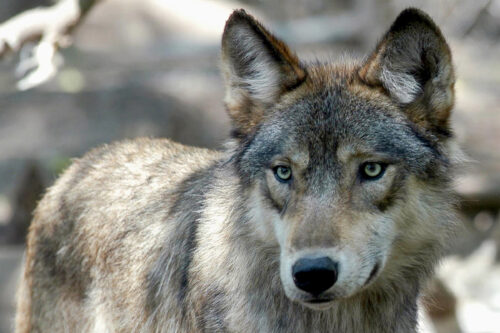
Photo: Dawn Villella
How did humans domesticate the wolf? One of the first things I learned is that this is the wrong question to ask. It puts humans at the center and in charge. Greger Larson, an evolutionary geneticist at Oxford, points out that we treat the verb to domesticate as transitive, as if a human subject acted on an animal object. This would mean that many thousands of years ago some people envisioned a domesticated wolf and acted on that vision, even though such an animal had never existed before. Further, the question treats the animal’s actions and needs as irrelevant. What part did the wolf play? Finally, the question sidesteps the possibility that humans were also changed—domesticated, if you will. Maybe humans and dogs co-evolved.
Current research suggests that we did. Domestication was a dynamic process in which two species adapted to and alongside each other, with natural selection driving change. Larson prefers the term relationship to describe the early interactions between humans and other species. The relationship conferred an advantage that helped both species survive and have viable offspring. How the relationship unfolded would have been mutual, situational, improvisational, and gradual.
So, how did humans and a now-extinct species of wolf develop a relationship that transformed wolves into dogs? The most plausible story I’ve found is based on climatological, archeological, genetic, and nutritional research. This hypothesis could change, however, as new evidence is discovered.
The story begins roughly 30,000 years ago during the last great Ice Age, as ice sheets advanced south across Eurasia and North America. They reached their greatest spread from 23,000 to 19,000 years ago, during a period called the Last Glacial Maximum, when glaciers covered about 25% of the earth’s land area. Forced to move as the ice advanced and the climate changed, many animals found refuge on a large plain in northeastern Siberia that remained free of glacial ice and was slightly warmer. Prey animals such as mammoths, bison, and horses migrated there starting around 30,000 years ago—and predators followed, including wolves and humans. The climate was harsh but the plain provided vegetation for grazing animals, who provided meat for predators. There, humans and animals remained, cut off from the rest of the world until roughly 15,000 years ago.

Glacier on Ellesmere Island
A 2021 examination of the ancient genetics of both humans and dogs reveals that dogs may have come into being in this region during this period, about 23,000 years ago, alongside people known as the Ancient North Siberians. Then, 15,000 years ago as the glaciers retreated (the Ice Age fully ended roughly 12,000 years ago), people and their dogs dispersed east into the Americas and west across Eurasia.
By about 25,000 years ago, Brian Hare and Vanessa Woods note in Survival of the Friendliest, humans had become essentially modern. We had revolutionized hunting. We had developed throwers, akin to the Chuckits we use now to throw balls for our dogs in the park, that propelled spear shafts tipped with stone points “more than 300 feet at better than 100 miles per hour,” as Hare and Woods report. With these spear throwers we could hunt large animals such as mammoths and swift ones like horses—and could rely more on hunting and less on gathering.
We had also developed the tools and skills to make clothing and shelters, and our camps had become larger and more organized. We processed and cooked our food. Areas within a camp were divided and dedicated to butchering, cooking, sleep, and waste. We made jewelry and art and had developed trade networks. In the harsh conditions of Ice Age Siberia, human camps were limited to about 25 people. Still, these groups communicated with one another and married out of their small family clusters.
On this arctic plain in northeastern Siberia, wolves and humans had less space to avoid each other, and over hundreds and then thousands of years the two species formed a relationship. Some wolves crept closer to the human camps and hunting sites—reacting less fearfully to people and fleeing less quickly when people approached—and took advantage of what the bands of people left, such as the remains of a kill. In other words, a set of wolves moved into a promising new ecological niche near humans and began to adapt to it. A combination of the brutal climate and forced proximity started a process of evolutionary change.
But in such challenging circumstances wouldn’t wolves and humans have competed for food? What could humans possibly leave for scavenging wolves? Two surprisingly mundane answers have been proposed: poop and leftovers.
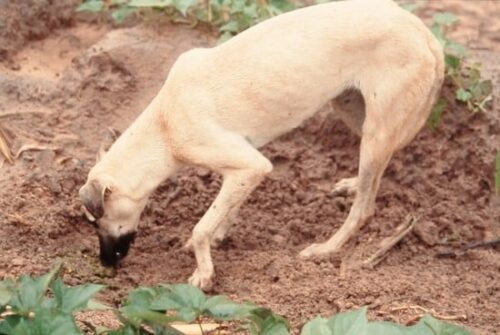
If you know dogs, you know dogs who eat poop. Our dog Bailey used to wander around the yard grazing on rabbit droppings. She also used to raid the cat box if we didn’t block the door. To our neighbors’ dismay, their dog Lonzo has a knack for finding and eating human poop in the woods. (The 2018 study I’m using here calls poop an “anthropogenic food subsidy,” a delightfully tidy way to describe human shit.) While poop-eating seems disgusting, today in many parts of the world free-ranging dogs depend on it. Human waste is rich in energy and protein, so much so that eating human feces is equivalent to eating the remains of a small mammal. What’s more, poop has an advantage over a mammal: it won’t run away. The hypothesis goes that the Ice Age wolves who tolerated human proximity started scavenging human feces near human encampments and eventually quit hunting with their family groups.
These wolves also got leftovers—“a surplus of animal derived protein that could have been shared with incipient dogs,” according to a 2021 study. It’s hard to believe that people would discard any food during a brutal Ice Age winter, but they did. Humans are not typical carnivores. Our ancient primate ancestors ate plants and insects, and were prey rather than predators. Later in our evolution we became predators, too, but our digestive systems never fully adapted to a carnivorous diet. We can only meet about 20% of our energy needs from protein, and too high a concentration of protein in our diet can sicken or kill us. As a result, during the Ice Age winters when the store of plant-based foods dwindled and the prey animals grew lean, we consumed lots of fat, a rich source of energy. There’s archaeological evidence that we butchered our kills to focus on the fatty parts. We couldn’t consume all the lean meat, and possibly carcasses were only partly processed.
By contrast, wolves are typical carnivores. They consume a greater proportion of protein within their diet and are able to rely entirely on protein for months at a stretch. This means that wolves and humans have complementary nutritional needs and could eat different parts of the same kill. With a supply of poop and leftovers, the new ecological niche created by humans enabled the wolves who took advantage of it to survive.
Still, how did the wolf turn into the dog? It’s one thing to scavenge successfully around human camps, but quite another to evolve into a new kind of creature. The story of dog domestication picks up, still in Siberia but many thousands of years later, with what Hare and Woods and many others consider “the greatest behavioral genetic experiment of the twentieth century.” This experiment revolutionized the way we think about domestication.
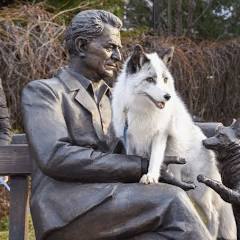
A statue honoring Dmitry Belyaev (1917-1985) with one of the foxes.
The experiment’s design was simple and audacious: Start at the beginning. This time, the transitive verb to domesticate most definitely applies, since the experimenters had a vision and a plan: to domesticate silver foxes, another canid, in order to understand how wolves might have become dogs. In 1959, the geneticist Dmitry Belyaev and his associate Lyudmila Trut set to work at a silver fox fur farm near Novosibirsk, 2000 miles east of Moscow. The farm foxes were captive but not domestic. Belyaev and Trut sorted hundreds of seven-month-old foxes into two groups: a friendly group and a control group. When Trut stood in front of the cage and tried to touch the animal (wearing thick protective mitts), some foxes retreated to the back of the cage while others showed interest and even approached her. The top 10% of the friendliest foxes were chosen for breeding. They continued this practice across many generations.
The results were remarkable. First, the foxes became friendlier. Within six generations—that’s only six years—a small group of the foxes started acting like friendly dogs. They could be petted and picked up, they licked people’s hands, and they whined and wagged their tails. Fifteen generations into the experiment, Trut took one of the kits, Pushinka, into a small house to live with her to test whether the foxes could live with people. They bonded so closely that Pushinka curled up beside Trut in bed. Almost all of the foxes bred in the experiment are now this calm and friendly.
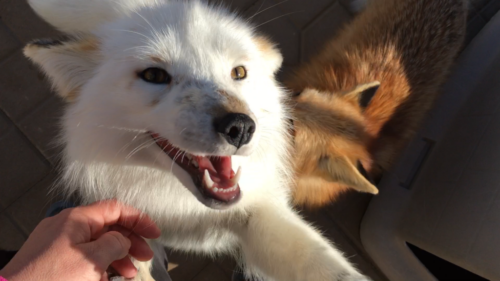
After 20 years and 20 generations, their bodies began to change. Many developed pie-bald coats, floppy ears, and curly tails. The adult foxes looked younger, with shorter, rounder snouts, smaller teeth, shorter limbs, and stockier bodies. Their reproductive cycles shifted: they came to sexual maturity earlier, had larger litters, and could have litters more than once a year. Finally and probably most importantly, their hormonal development and levels changed. Hormonal surges of corticosteroids, stress hormones, started later during the development of the friendly fox kits; and when they did start, the surges were milder. Overall, corticosteroid levels dropped by half within 15 generations, leading to much less predatory and defensive aggression. Within 30 generations, levels dropped by half again. Their adrenal glands gradually shrank. Within 50 generations, their serotonin levels rose by an order of five, making these foxes “happier,” as evolutionary biologist Lee Alan Dugatkin puts it.
Selectively breeding the foxes based on friendliness alone initiated a cascade of behavioral, morphological, reproductive, and hormonal changes. Somehow, seemingly unrelated genetic changes hitched a ride as the silver foxes grew tamer and tamer. This pattern can be seen in other domestic species as well—such as the red jungle fowl, the origin species of the chicken—and is known as domestication syndrome. This experiment suggests how wolves turned into dogs.
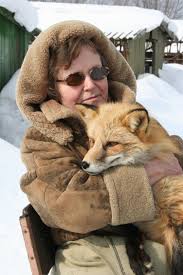
Lyudmila Trut with one of the domestic foxes. She died in October, 2024.
The silver fox experiment supercharged a natural evolutionary process. Within Lyudmila Trut’s lifetime, rather than across hundreds and thousands of years, these silver foxes became domesticated. People now keep them as pets. In fact, sales of the kits help support the ongoing experiment.
Hare and Woods offer a surprisingly straightforward explanation of domestication: it “occurs when animals who are friendly toward people become more successful at reproducing.” That’s pretty simple! The friendly wolves that scavenged around the human camps tended to breed together, producing pups who were even friendlier and better adapted to their new ecological niche. These dogs-in-the-making gradually became more isolated from wild wolves, and across many, many generations small changes became large ones. As they evolved within their new habitat, they domesticated themselves.
Over time, humans took in some of the puppies, recognized and took advantage of dogs’ abilities that complemented and enhanced our own, and began to select the dogs that best embodied those abilities.
We ended up with the miracle that is the domestic dog—and I am deeply grateful!
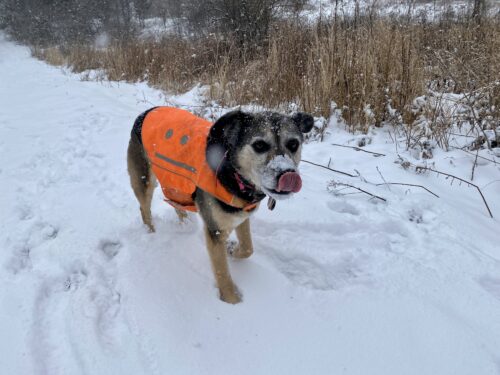
Photo: Rachel Ribis
References (in the order of their first appearance):
Starting in 2016, Greger Larson persuaded scientists from around the world to stop working in silos and to share samples from ancient dog remains so that all researchers could have access to the best DNA data. This expanded database has enabled researchers to make breakthroughs, including the study that provides the background for the main hypothesis I’m presenting here, which traces the dog’s genetic trail back to about 23,000 years ago in northeastern Siberia.
Larson is an effective speaker who explains domestication, evolution, and genetics clearly for a general audience. Check out these two interviews:
Justina Desriute and Brian Dilg. “Domestication with Greger Larson.” Dogstorian Season 1, Episode 3 (July 20, 2022).
Ricardo Lopes. “Greger Larson: Animal Domestication and Human Evolution.” The Dissenter #828 (August 31, 2023).
James Gorman. “The Big Search to Find Out Where Dogs Came From.” New York Times, January 18, 2016.
Patrick Pester and Kim Ann Zimmermann. “Pleistocene Epoch: The Last Ice Age.” LiveScience, February 28, 2022.
Angela Perri, et al. “Dog Domestication and the Dual Dispersal of Dogs and People Into the Americas.” Proceedings of the National Academy of Sciences, Vol 118, #6 (January 25, 2021).
James Gorman. “In Ice Age Siberia, a Meeting of Carnivores May Have Given Us Dogs.” New York Times, January 25, 2021.
David Grimm. “Ice Age Hunters May Have Domesticated Dogs 23,000 Years Ago.” Science, January 25, 2021.
Brian Hare and Vanessa Woods. Survival of the Friendliest: Understanding Our Origins and Rediscovering Our Common Humanity. Random House, 2020.
Survival of the fittest does not necessarily mean competition and struggle; fitness is simply whatever facilitates survival and the reproduction of viable offspring. Hare and Woods propose that friendliness, or “positive behavior toward others,” is an “advantageous evolutionary strategy.” Certain species are more disposed than others to develop a relationship with people. Only a few have entered this relationship: horses but not zebras, one wolf species but not others, one wild cat species but not others. Hare and Woods report, however, that there’s evidence that in the present day that a number of wild species are adapting to their forced proximity to humans and beginning the process of self-domestication.
James R.A. Butler, et al. “Anthropogenic Food Subsidy to a Commensal Carnivore: The Value and Supply of Human Faeces in the Diet of Free-Ranging Dogs.” Animals 2018 (Vol 8, #5).
Maria Lahtinen, et al. “Excess Protein Enabled Dog Domestication During Severe Ice Age Winters.” Scientific Reports 11, #7 (2021).
James Gorman. “The Leftover Route to Dog Domestication.” The New York Times, January 8, 2021.
Lee Alan Dugatkin. “The Silver Fox Domestication Experiment.” Evolution: Education and Outreach, Vol. 11 (2018).
See Lee Alan Dugatkin and Aaron Dugatkin’s tribute to Lyudmila Trut, who died on October 9, 2024: “The Daring Russian Geneticist Whose Experiments on Silver Foxes Explained Domestication Has Died.” Scientific American, October 24, 2024.
For more about the silver fox experiment, see Hare and Woods’ book. Also, Lee Alan Dugatkin and Lyudmila Trut. How to Tame a Fox (and Build a Dog): Visionary Scientists and a Siberian Tale of Jump-Started Evolution. University of Chicago Press, 2017.
